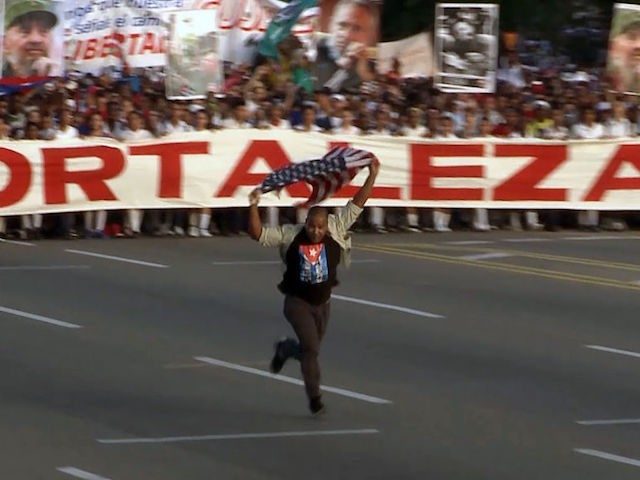The Cuban government has yet to release Daniel Llorente, a dissident arrested for waving an American flag during the nation’s communist May Day parade this year, from a mental health ward his family was told he was confined to following the incident because he believes in God.
The Cuban-American outlet Martí Noticias spoke to Llorente from the psychiatric ward where he has been kept since May this week. In the short call, Llorente says he has been told he needs a special form to be released from the institution, but keeps being refused the document. “I’ve been to several places, nobody tells me anything—all it is is waiting, waiting, waiting,” he lamented.
Llorente was beaten publicly by plainclothes state security agents on May 1 after he ran in front of the parade with his American flag. He was subsequently arrested but—partly due to international pressure from the human rights community, and partly due to Llorente’s status as not a member of any Cuban dissident or pro-democracy organization—the Cuban government did not place him in prison, despite awaiting trial on charges of “public disorder and resistance.”
Instead, police placed Llorente in a “mental health facility” that most in the Cuban exile community know as the dreaded “Mazorra,” which the government traditionally used for mental health cases professionals deemed hopeless. Llorente’s family has said that he has since been deprived of sunlight and forced to take unidentified medications, which he told relatives sedated him.
“They say that since he believes in God and is always talking about that … they say that is a disorder,” teenage son Eliécer Llorente told Martí in June. “That is a lie. He told me to talk to journalists from the first day I visited him because he signed himself out of the institution and has not been let out.”
Llorente attempted to go on hunger strike temporarily in June.
Llorente had previously caused a commotion in May 2016, when the first American cruise ship came to shore in Havana. At the time, Llorente brought his American flag to greet the ship and was arrested while shouting “yes we can!” the slogan of the Barack Obama presidential campaign. At the time, Llorente said on camera that Cubans attending the May Day parade were “hypocrites” and that he waved the American flag because “I don’t fear the government.”
The use of alleged psychiatric treatment to contain outspoken anti-communist dissidents has long been part of the Cuban regime’s approach towards oppressing its opponents. Communist officials have apparently attempted to use the threat of psychiatric detention with other dissidents—in a recent case, with three men who publicly opposed celebrations of the 26 of July.
Cuba observes July 26 as a holiday, as on this date in 1953, Fidel Castro and his cronies violently attacked the Moncada Barracks, killing fifteen soldiers and three police officers—an event the communist dictatorship celebrates.
On July 26, 2017, three men—brothers Alberto and Leonardo Ramírez Odio and father Alberto de La Caridad Ramírez took to a balcony with large signs reading “58 years of deceit, hunger, and misery” and “the people demand freedom, justice, democracy.” The men chanted “Down with the dictatorship! Down with Fidel! Down with Raul!” They were summarily beaten by an official state gang and arrested.
Last week, family reported that the three were taken to a psychiatric hospital and kept on a bus to watch from afar for about an hour before being returned to prison. The trip appeared to be a threat to keep them imprisoned in a psychiatric facility without a trial, indefinitely.
The Cuban regime has become significantly more violent against dissidents since President Barack Obama announced a series of diplomatic concessions to the Castro regime in 2016. According to the Cuban Commission for Human Rights and National Reconciliation (CCDHRN), an NGO that tracks politically-motivated arrests on the island, the number of political prisoners in Cuba doubled between April 2016 and April 2017. President Obama visited Cuba—the first such visit of an American head of state in decades—in March 2016.

COMMENTS
Please let us know if you're having issues with commenting.